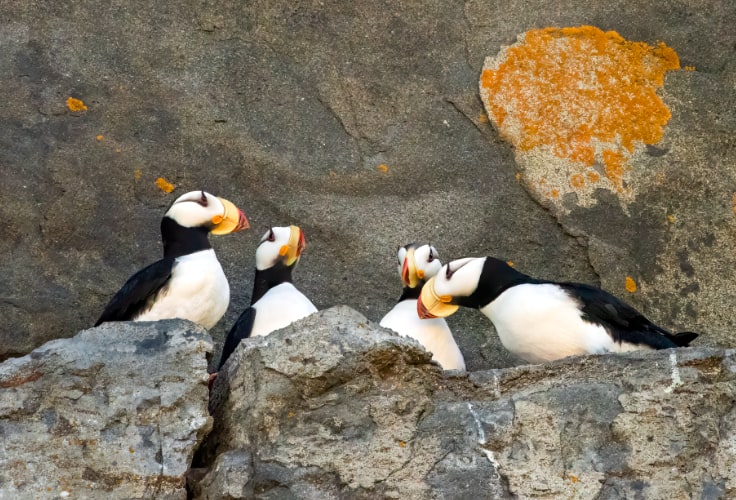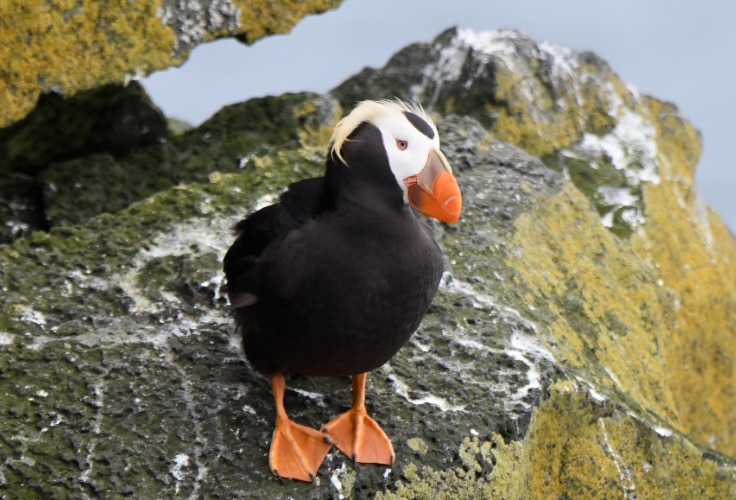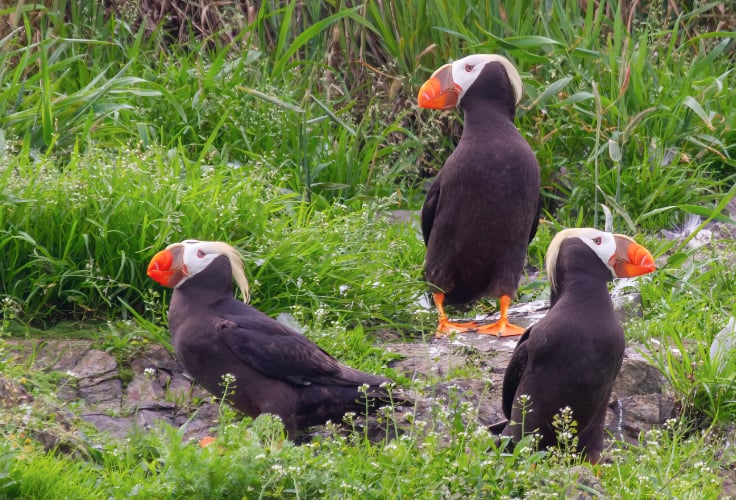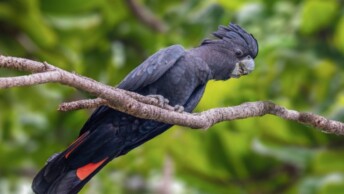Alaska is the heart of North America’s puffin world. Each summer, millions of seabirds return from the open Pacific to breed on the cliffs and islands scattered along the state’s vast coastline, from the temperate fjords of the southeast to the wind-lashed rocks of the Bering and Chukchi Seas. Nowhere else on the continent do puffins occur in such numbers or variety.
Two species nest widely here: the horned puffin, with its white face and small dark “horns,” and the tufted puffin, instantly recognized by its golden head plumes. They share Alaska’s rugged marine landscapes with murres, kittiwakes, and auklets, raising their young in burrows or cliff crevices that overlook some of the richest feeding grounds on the planet.
Horned Puffin
Fratercula corniculata
- Identification: Medium-sized, black-and-white seabird with a very thick yellow-and-red, triangular bill, white face, and bright orange legs and feet.
- Where found: Breeds throughout coastal and island Alaska, from the Gulf of Alaska and Aleutians north through the Bering and Chukchi Seas. Winters far offshore across the central North Pacific.
- How to spot: Look for its football-like body, rapid direct flight, bold white underside, and at close range, the small dark “horn” above the eye. During summer, best seen nesting on cliffs and rocky islands or rafting in groups near colonies.
- Conservation status: Least Concern (IUCN); abundant and widespread in Alaska, though periodic die-offs and prey shortages linked to warming seas and marine debris are causes for concern.

The horned puffin is the defining puffin of Alaska – its bright bill and white-faced, tuxedo-like plumage symbolizing the seabird cliffs of the North Pacific. Adults reach 36-41 centimeters (14.2-16.1 inches) in length and have a compact, thick-set appearance with short wings adapted for both flight and diving. It is one of two puffin species that nest commonly in Alaska, the other being the tufted puffin.
Breeding adults are sharply marked: black above and gleaming white below, with a creamy white face, dark “neckline,” and vivid orange feet. The large bill glows yellow with a red tip in summer, and a small dark fleshy spike (or “horn”) – projects above each eye. After breeding, facial skin darkens to gray, and the horn and outer bill sheaths are shed, leaving a duller look at sea. Males and females appear similar, though males are slightly larger on average.

Horned puffins spend most of the year at sea but return to their colonies in May. They breed on rocky islands and steep coastal cliffs throughout Alaska, including the Semidi, Shumagin, Sanak, Pribilof, St. Matthew, and St. Lawrence Islands, as well as Cape Lisburne in the Chukchi Sea – the northernmost known site. Some nest as far east as Cooper Island near Point Barrow, marking the Arctic limit of their range. Nests are placed in cracks, boulder crevices, or burrows dug into grassy slopes, where a single egg is laid each year.
At sea, puffins are fast and direct fliers, their short wings beating rapidly as they skim low over the waves. They dive to chase small schooling fish such as sand lance, capelin, and smelt, carrying multiple fish crosswise in their bills. During the breeding season, they gather in rafts near colonies and often circle cliffs in noisy, looping flights. Visitors can observe them easily from birding sites like St. Paul Island in the Pribilofs, the Alaska Peninsula, and parts of the Aleutians and Kenai Peninsula, especially from June through August.
Horned puffins are still common in Alaska and make up the vast majority of the world population, yet they are sensitive indicators of ocean change. Mass die-offs in recent warm-water years have been linked to declines in forage fish, while ingestion of plastic and other marine debris poses additional risks. Nearly all major colonies lie within protected areas such as the Alaska Maritime National Wildlife Refuge, offering vital safeguards for this emblematic species of Alaska’s northern seas.
Tufted Puffin
Fratercula cirrhata
- Identification: Large puffin with an all-dark body, white face, long golden head plumes, thick orange bill, and bright orange legs.
- Where found: Breeds abundantly on coastal cliffs and offshore islands throughout Alaska, from the Gulf of Alaska and Aleutian Islands north through the Bering and Chukchi Seas. Winters far offshore across the central North Pacific.
- How to spot: Look for its black body, white face, and long golden tufts sweeping back from the crown; often seen circling colonies or rafting in small groups near nesting islands in summer.
- Conservation status: Least Concern (IUCN); still numerous in Alaska, though vulnerable to warming seas, shifts in prey, and introduced predators on some islands.

The tufted puffin is Alaska’s most striking seabird, instantly recognizable by its flowing golden plumes and glowing orange bill. It is the largest of the world’s puffins, reaching 36-42 centimeters (14.2-16.5 inches) in length, with a stocky, deep-bodied shape and short wings built for powerful underwater flight. Across Alaska’s islands and coasts, its dark silhouette and gleaming face are among the most familiar sights of summer seabird cliffs.
In breeding plumage, adults are blackish overall with a clean white face and long, curling golden tufts that sweep behind the head. The heavy bill is orange with red and yellow tones and features a small fleshy rosette at the base; legs and feet are bright orange. Outside the breeding season, the face darkens and the bill plates and plumes are shed, giving a duller appearance. Both sexes look alike, though males tend to be slightly larger.

Tufted puffins arrive at Alaskan colonies in May, nesting by the thousands on grassy slopes, cliff edges, and talus crevices of offshore islands. They excavate burrows up to 1.5 meters deep, where a single egg is laid. Major colonies occur in the eastern Aleutians (e.g., Egg, Aiktak, Chagulak, and Buldir Islands), the Semidi and Shumagin groups, the Pribilofs, St. Matthew and St. Lawrence Islands, and north to Cape Lisburne in the Chukchi Sea – the northern limit of their range. The vast majority of the world’s tufted puffins breed in Alaska, making it their global stronghold.
At sea, these puffins are powerful fliers, beating their wings rapidly and often flying low over the water in small flocks. They dive with half-open wings to chase schooling fish, squid, and crustaceans, sometimes carrying several prey items crosswise in their bills. During June and July, they form dense rafts near colonies and perform looping flight displays over cliffs, especially in calm weather. Excellent viewing sites include St. Paul Island in the Pribilofs, the Kenai Peninsula, the Semidi Islands, and coastal waters around Kodiak and the Alaska Peninsula.
Although tufted puffins remain common, they face growing ecological pressures. Warm-water events in the Bering Sea and Gulf of Alaska have triggered major seabird die-offs due to prey shortages. Introduced foxes and rats have eliminated colonies on some islands, while plastic ingestion and residual bycatch in fishing gear continue to pose risks. Most large colonies now lie within the Alaska Maritime National Wildlife Refuge, providing strong protection for this spectacular symbol of Alaska’s marine birdlife.
Where to See Puffins in Alaska
Alaska hosts immense colonies of both horned and tufted puffins, two iconic seabirds of the North Pacific. They breed by the hundreds of thousands on cliffs and offshore islands from Southeast Alaska to the Bering Strait, forming one of the largest puffin populations in the world. Many can be seen from coastal viewpoints or small boats, but the best sightings come on summer wildlife cruises from May through August, when adults are nesting and feeding chicks.
Kenai Fjords National Park
Accessible from Seward, this area offers some of Alaska’s most reliable puffin watching. Both horned and tufted puffins nest on the steep cliffs of the Chiswell Islands and along the fjords near Aialik and Northwestern Glacier. Daily wildlife cruises operate throughout summer, often accompanied by murres, kittiwakes, humpback whales, and sea otters.
Kodiak and the Alaska Peninsula
Tufted puffins nest in large numbers on offshore stacks and islands around Kodiak, while horned puffins prefer rocky crevices and cliffs. Local marine tours and fishing charters frequently encounter them near Marmot Bay, Ugak Island, and the Shumagin group farther west. Puffins are typically seen rafting on calm water near colony cliffs or flying low over the waves.
Pribilof and Aleutian Islands
These remote island chains host immense colonies of both puffin species. St. Paul Island in the Pribilofs offers accessible viewing sites such as Reef Point and Ridge Wall, where puffins can be observed from land at close range – one of the few places in the world where that’s possible. In the Aleutians, colonies are widespread but often accessible only by expedition cruises or research charters.
Southeast Alaska
Smaller numbers of tufted puffins breed on islands near Sitka, Juneau, and Glacier Bay. Sightings are frequent on summer wildlife and whale-watching tours, particularly near St. Lazaria Island off Sitka and along Icy Strait. These locations offer some of the easiest opportunities to see puffins while also exploring the state’s rich marine wildlife.
When to Go
Puffins return to Alaska’s islands in May and remain through early September, with peak viewing in June and July. Colonies are busiest in calm weather when adults shuttle fish to their burrows. Morning and evening light often provide the most active and photogenic conditions. Outside this brief window, puffins spend the rest of the year far offshore in the open North Pacific.



